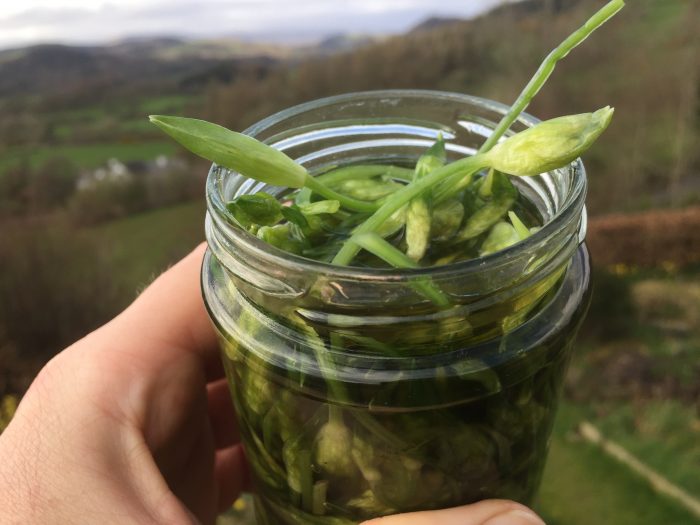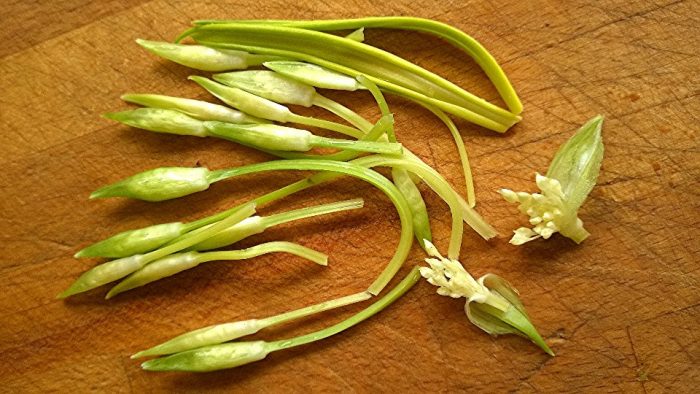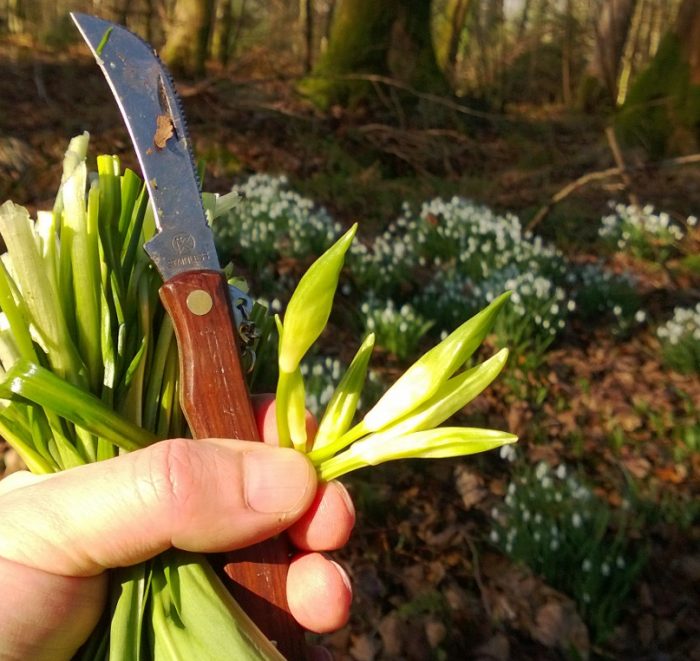Salted Pickled Wild Garlic Buds
Of the very many delicious things you can do with wild garlic, this is possibly my favourite. Its a simple preparation but you can jazz it up with some wild aromatics in the pickling solution.
Salting before pickling in vinegar helps with preservation which allows you to tone down the acidity of the vinegar without significantly reducing the shelf life. Undiluted vinegar is just too much for all but the coarsest pickle-palates, overpowering the star of the show, and burning away at nutrients. Salting also intensifies the flavour of what you are pickling, by drawing out moisture.
Related Posts:
- Wild Garlic – Identification, Edibility, Distribution
- How to ferment wild greens
- Ground ivy and wood avens root shrub
- Wild garlic, goats cheese and hazelnut pesto
- How to pickle wild mushrooms
Wild garlic buds are a delight in every way. You can decorate salads with them, ferment them, or add them into anything savoury, where their beauty and allium pungency will light up any dish. You could also use the buds of three cornered leek or few flowered leek for this recipe, though the buds of the latter are very small and fiddly. The firm white stems and green seed pods/bulbils can also be preserved in this way.
To my mind ramson buds are rather too special to use where the less glamorous parts of ramsons do just as well. This recipe lets them shine in all their pungent glory!
Pretty much as soon a wild garlic leaves start to unfurl (February to March in the UK, depending where you are), these wee buds of joy will be nestling at their bases, initially swaddled by the stems, so its inevitable you will bring home a few when harvesting early leaves. Salting and pickling is a great way of accumulating them, as its easy to prepare small amounts and add them into your pickle solution. But generally its better to wait until they swell and thrust themselves skyward in April to harvest them. At this stage they are larger and easier to carefully harvest, a few here, a few there, until you’ve accumulated a jar full. Remember that the flower is the business end of a plant, and if you over harvest you could significantly reduce the colony and the other species that rely on their abundance. Wild garlic can be very prolific, and it is in all our interests to keep it that way.
These wee ‘pickled onions’ will light up any salad, canape or stir fry , and are perfect with sushi. But I have been known to just scoff them by the forkfull!
The pickling solution I recommend for this recipe is ground ivy infused apple cider vinegar diluted with wood avens root syrup. This sounds complicated, but its quite easy and uses abundant, easy to identify plants. Ground ivy vinegar and wood avens root syrup are two things you should definitely have in your wild pantry. They are great for so many things, sweet, savoury and boozy. When mixed together the resulting vinegar (technically a “shrub” because it is sweetened) is my absolute go-to formulation for most of the savoury pickling I do – and is especially good for pickling seaweeds. Its also a magical shrub for balancing the acidity of cocktails.
Follow the recipe for ground ivy vinegar here (scroll down through the recipe to stage 3. Its as easy as infusing ground ivy leaves in apple cider vinegar!).
Follow the recipe for making wood avens root syrup here.
Mix the two liquids about 60% vinegar : 40% syrup, or to the sharpness you like. A PH of 4 or less will help the keeping properties. By way of guidance, lemon juice and most apple cider vinegar have a PH between 2 and 3.
If you don’t have the time or wherewithal to make this ambrosial nectar, salted ramson buds can still be delicious in a simple 3:2:1 pickle – 3 parts apple cider vinegar to 2 parts water to 1 part sugar (so that would be, say, 300 ml vinegar : 200 ml water : 100 g sugar). Stir it all together until the sugar is dissolved. If you are that way inclined, you could spice up this mix with some wild spices.
Note: I always use apple cider vinegar because its local to me, but you could use white wine or rice vinegar. Avoid the pungent flavours of malt vinegar and balsamic vinegar for this recipe.
I’m grateful to the wonderful Fergus Drennan who first passed on to me the traditional technique of pre-pickle salting. 🙂
Ingredients:
- Wild garlic buds, including their stems
- Sea salt
- Ground Ivy and cloveroot vinegar (see instructions and links above) OR 3:2:1 Apple cider vinegar : Water : Sugar mix, and feel free to add wild and tame aromatics, such as fennel seeds, bay leaves, star anise, alexander seeds, spignel, or anything else that takes your fancy from our native spice rack. Get creative!
Method:
Place the buds in a bowl and grind/spinkle salt on them. Go easy. No more than 1 teaspoon per 200g of buds.
Gently mix in the salt with your fingertips and put a plate over them.
Leave in the fridge for 3 or 4 days, perhaps giving them another gentle fingertip mix, but this isn’t really important.
After 3 or 4 days, strain off the liquid that has been drawn from the buds and repeat the salting process, using half as much salt as the first time.
Return the buds to the fridge for another few days.
Taste a bud. They will have drooped and softened but should still look very much like buds. Their flavour should be intensified, and fairly salty.
If you like what you are tasting (don’t worry, the saltiness is diluted when they are pickled) then proceed to the next step. If you think they could get more intense, repeat the salting process. A bit of trial and error is required here, but don’t worry, nothing can go wrong!
Strain the liquid from the bowl then loosely pack the buds into a very clean jar. Don’t rinse them unless you think you’ve really overdone the salting stage. Sterilising the jars is recommended if you intend to keep the pickles for any length if time. They don’t last long in our house, so I’m content to just wash the jar thoroughly and rinse with boiling water.
Top up the jar with your vinegar solution. Note the vinegar solution should be cold – heating it will destroy all the volatile compounds that make wild garlic so delicious!
Leave in the fridge for a week before eating.
Its possible to ‘top up’ your jar with freshly salted buds.
Don’t waste the tasty vinegar you’ve made – it can be reused for more pickling or in salad dressings.




9 Comments
Hi,
I picked 600g of wild garlic buds last week, then washed and brined them in 2 tsp of sea salt.
I them made a pickling liquor of 750ml of cider and rice vinegar, 100g brown sugar and 200ml water, plus aromats, brought to a boil then cooled.
I then placed everything in a sterilised kilner jar, but since then I have an issue.
A week later now, every morning I open the jar to stir and it gives off a whoosh of gas and there are lots of bubbles coming up. The smell is quite strong too.
Can you please tell me why my picked garlic buds are fermenting so, and are the whole jar spoiled?
Many thanks in advance.
Mark
Hi,
I’m surprised they are fermenting with that ratio of vinegar : sugar. But it sounds like it is. I’d just let it play out and see what happens. So long as it doesn’t smell cheesy then it might just ferment out nicely. So maybe just treat it like a ferment now, and trouble-shoot it as per my guidance at the end of this post:
Thank you for posting…foraged some garlic buds and now pickling…
Fabulous website…great resource, would love to come along to one of your events in the future…
Love to Scotland. I have been foraging Ramsons for 2 weeks now….& just made soda bread incorporating some of my collect. Just making the pickled buds. Taking GREAT care not to over pick. Fab website. Thanks to you.
Thank you for this great idea! I salted a small batch of buds but after a couple of days the buds, which were tightly closed when I picked them, had all opened. Do you think I can still go ahead with the pickling solution?
Jude
Yes, no problem.
At least a year, kept in the fridge.
Hello!
I am wondering how long these will last for? I am hoping to save them for the fall.
All the best!
Yes, they will keep fine until autumn provided you sterilise the jars first, and keep them somewhere cool.
Mark.